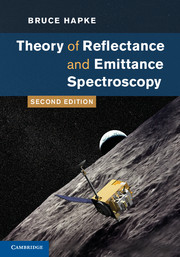Book contents
- Frontmatter
- Contents
- Acknowledgments
- 1 Introduction
- 2 Electromagnetic wave propagation
- 3 The absorption of light
- 4 Specular reflection
- 5 Single-particle scattering: perfect spheres
- 6 Single-particle scattering: irregular particles
- 7 Propagation in a nonuniform medium: the equation of radiative transfer
- 8 The bidirectional reflectance of a semi-infinite medium
- 9 The opposition effect
- 10 A miscellany of bidirectional reflectances and related quantities
- 11 Integrated reflectances and planetary photometry
- 12 Photometric effects of large-scale roughness
- 13 Polarization of light scattered by a particulate medium
- 14 Reflectance spectroscopy
- 15 Thermal emission and emittance spectroscopy
- 16 Simultaneous transport of energy by radiation and thermal conduction
- Appendix A A brief review of vector calculus
- Appendix B Functions of a complex variable
- Appendix C The wave equation in spherical coordinates
- Appendix D Fraunhofer diffraction by a circular hole
- Appendix E Table of symbols
- Bibliography
- Index
3 - The absorption of light
Published online by Cambridge University Press: 05 January 2012
- Frontmatter
- Contents
- Acknowledgments
- 1 Introduction
- 2 Electromagnetic wave propagation
- 3 The absorption of light
- 4 Specular reflection
- 5 Single-particle scattering: perfect spheres
- 6 Single-particle scattering: irregular particles
- 7 Propagation in a nonuniform medium: the equation of radiative transfer
- 8 The bidirectional reflectance of a semi-infinite medium
- 9 The opposition effect
- 10 A miscellany of bidirectional reflectances and related quantities
- 11 Integrated reflectances and planetary photometry
- 12 Photometric effects of large-scale roughness
- 13 Polarization of light scattered by a particulate medium
- 14 Reflectance spectroscopy
- 15 Thermal emission and emittance spectroscopy
- 16 Simultaneous transport of energy by radiation and thermal conduction
- Appendix A A brief review of vector calculus
- Appendix B Functions of a complex variable
- Appendix C The wave equation in spherical coordinates
- Appendix D Fraunhofer diffraction by a circular hole
- Appendix E Table of symbols
- Bibliography
- Index
Summary
Introduction
The differential reflection and scattering of light as a function of wavelength form the basis of the science of reflectance spectroscopy. This chapter discusses the absorption of electromagnetic radiation by solids and liquids. The classical descriptions of absorption and dispersion are derived first, followed by a brief discussion of these processes from the point of view of quantum mechanics and modern physics. Finally, the various types of mechanisms by which light is absorbed are summarized.
Classical dispersion theory
Conductors: the drude model
The simplest model for absorption and dispersion by a solid is that of Drude (1959). This model assumes that some of the electrons are free to move within the lattice, while the ions are assumed to remain fixed. These approximate the conditions within a metal. The average electric-charge density associated with the semifree electrons is equal to the average of that associated with the lattice ions, so that the total electric-charge density ρe = 0. Because the quantum-mechanical wave functions of the conduction electrons are not localized in a metal, the local field Eloc seen by the electrons is equal to the macroscopic field Ee. Thus, the force on each electron is –e0Ee, where e0 is the charge of an electron. Assume that Ee is parallel to the x -axis.
In addition to the electric field, there is a force due to collisions of each electron with the lattice, resulting in nonradiative loss of energy.
- Type
- Chapter
- Information
- Theory of Reflectance and Emittance Spectroscopy , pp. 27 - 44Publisher: Cambridge University PressPrint publication year: 2012



